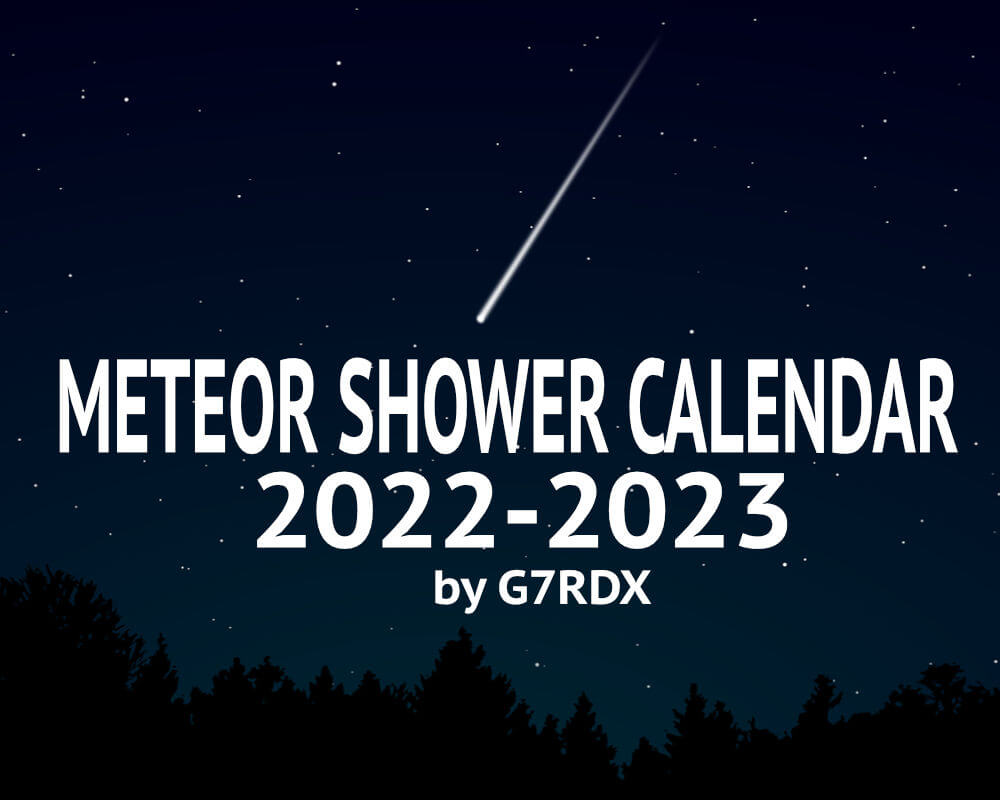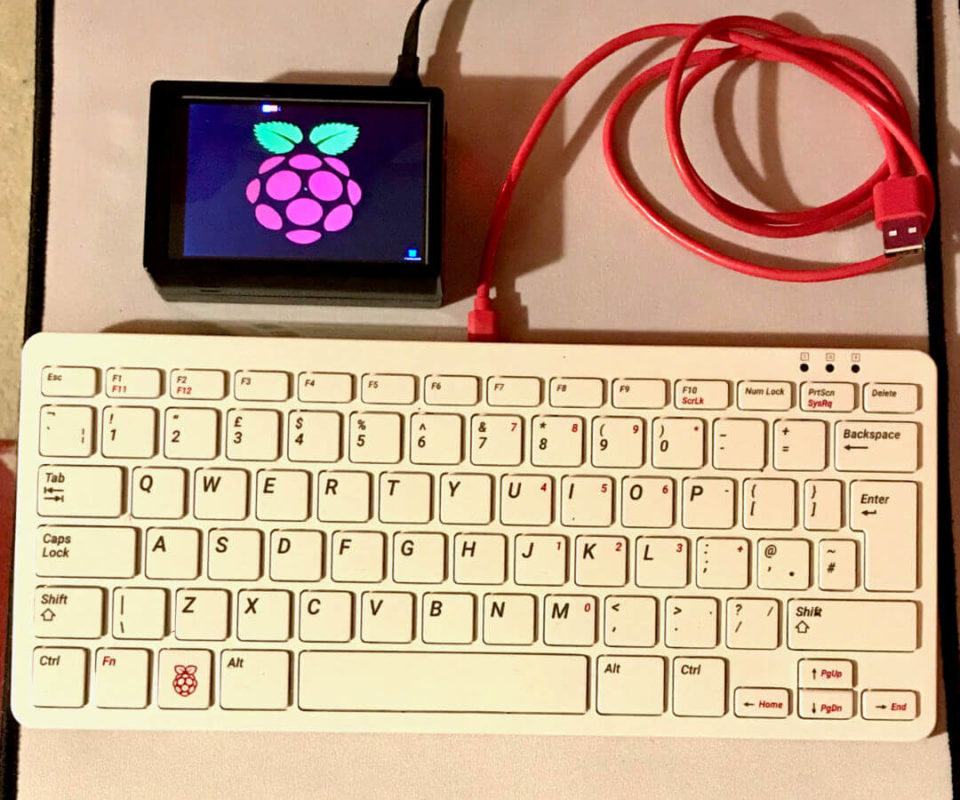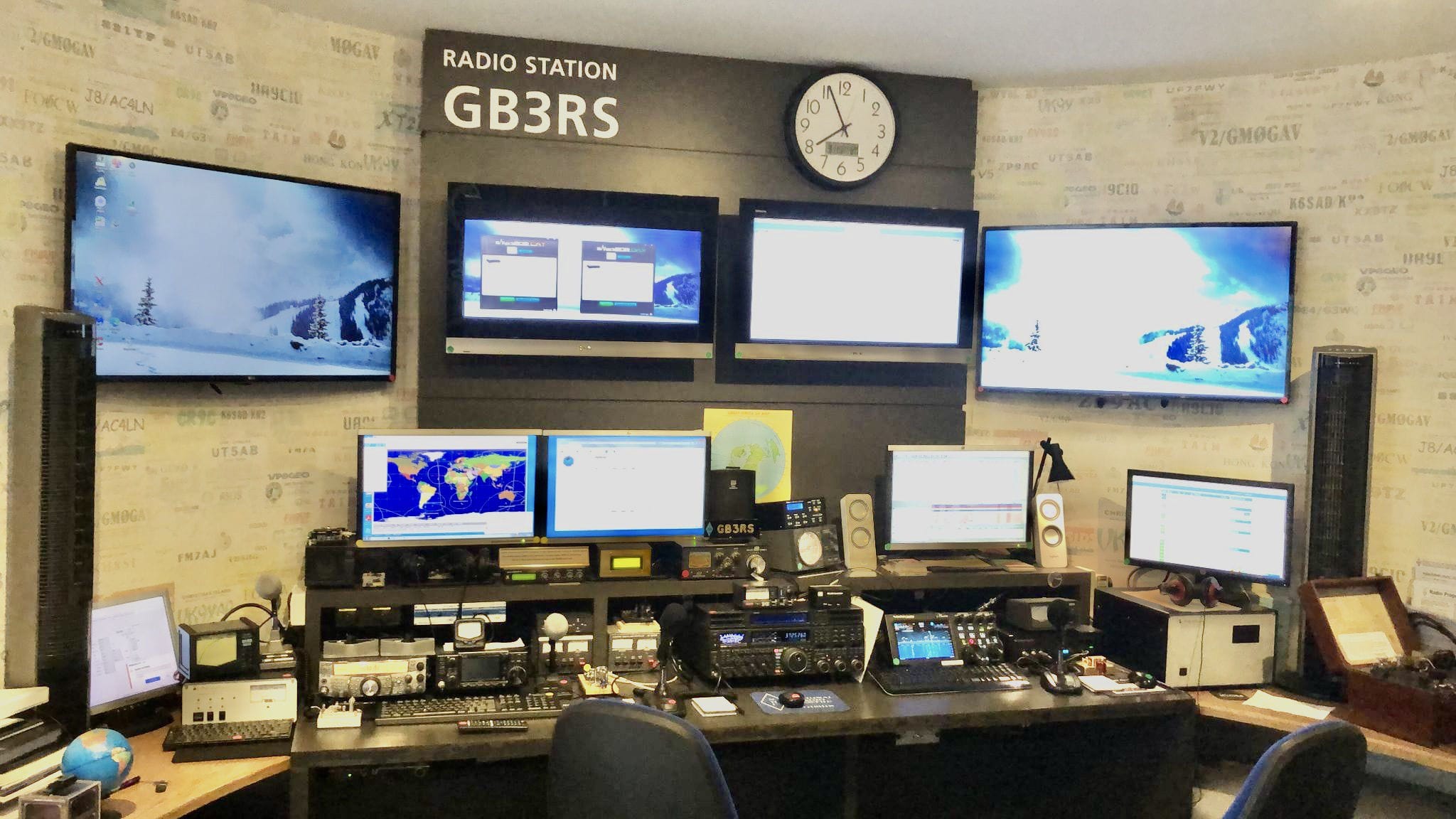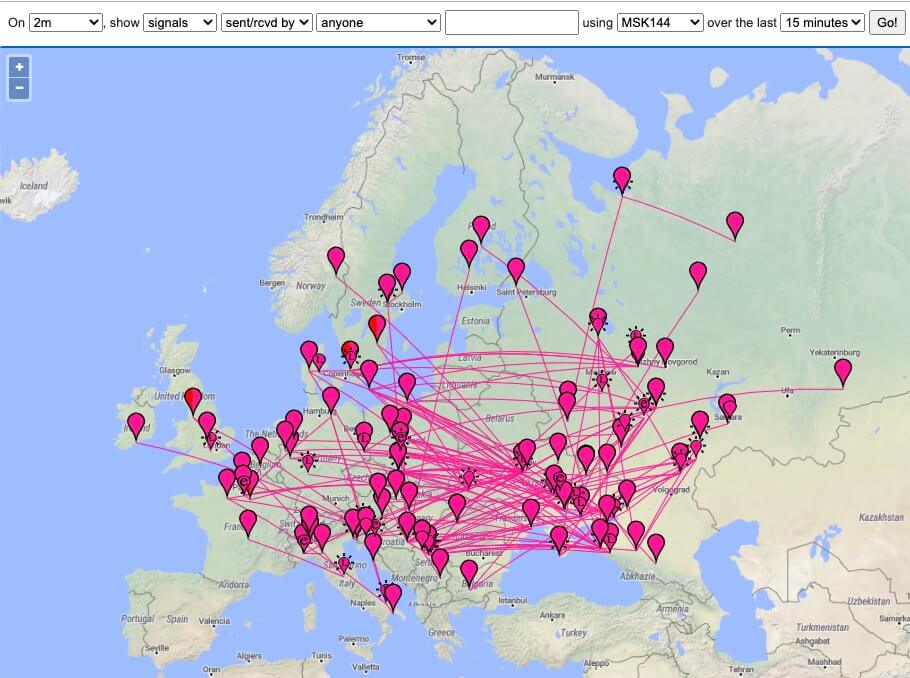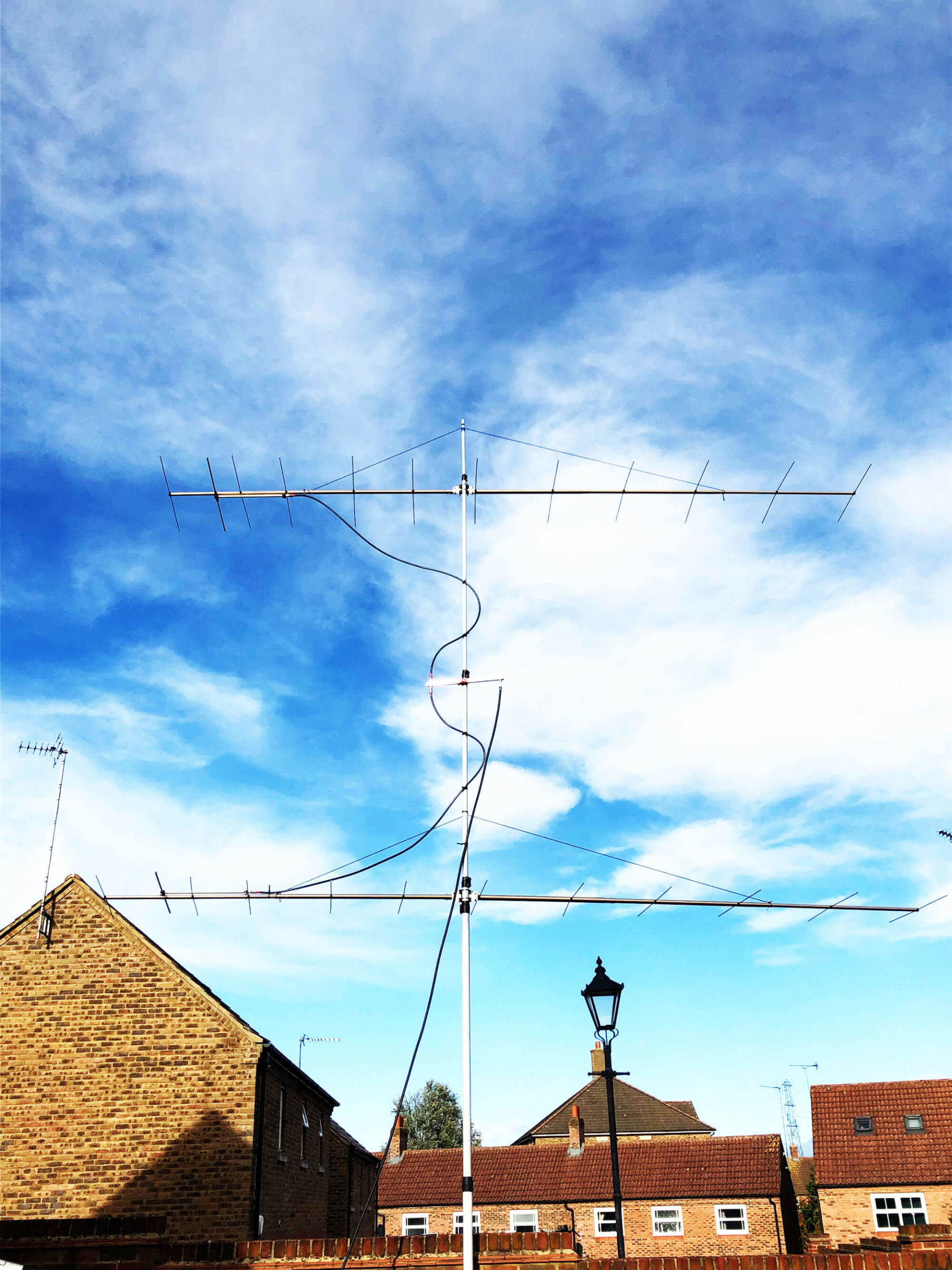Meteor Shower Peaks 2023
Hamradio VHF enthusiasts use meteor scatter to make contacts over distances up to 2000 km.
With several major events taking place throughout the year, you’ll want to make sure you’re prepared to take advantage of these celestial events.
Here’s a table summarizing the meteor showers in 2023, including their activity dates, peak dates, and ZHRs:
| Meteor Shower | Activity Dates | Peak Dates | ZHR |
|---|---|---|---|
| Quadrantids | Dec 28 – Jan 12 | Jan 3-4 | 120 |
| Lyrids | Apr 16-25 | Apr 22-23 | 20 |
| Eta Aquariids | Apr 19 – May 28 | May 5-6 | 60 |
| Perseids | Jul 17 – Aug 24 | Aug 12-13 | 100 |
| Orionids | Oct 2 – Nov 7 | Oct 21-22 | 20 |
| Northern Taurids | Oct 20 – Dec 10 | Nov 11-12 | 5 |
| Leonids | Nov 6-30 | Nov 16-17 | 15 |
| Geminids | Dec 4-17 | Dec 13-14 | 120 |
| Delta Aquarids | Jul 12 – Aug 23 | Jul 30-31 | 20 |
| Ursids | Dec 17-26 | Dec 21-22 | 10 |
Quadrantids: January 3-4 (ZHR 120)
The Quadrantids meteor shower is active from December 28 to January 12, with its peak on the night of January 3-4. This shower is known for producing bright, fast-moving meteors, making it a great target for radio detection. Amateur radio operators can listen for reflections of the signals they transmit off of the ionized trails left behind by these meteors. The ZHR for the Quadrantids is 120, which means that under ideal conditions, observers can expect to see 120 meteors per hour.
Lyrids: April 22-23 (ZHR 20)
Active from April 16-25, with its peak on the night of April 22-23, the Lyrids meteor shower is caused by debris from the Comet Thatcher. This shower produces relatively few meteors per hour, but they tend to be bright and long-lasting. Radio operators can listen for reflections of their signals off of the ionized trails created by these meteors. The ZHR for the Lyrids is 20, which means that observers can expect to see around 20 meteors per hour under ideal conditions.
Eta Aquariids: May 5-6 (ZHR 60)
The Eta Aquariids meteor shower is active from April 19 to May 28, with its peak on the night of May 5-6. This shower is caused by debris from Halley’s Comet, and produces fast-moving meteors that can be challenging to detect via radio. However, radio operators can still listen for reflections of their signals off of the ionized trails left behind by these meteors. The ZHR for the Eta Aquariids is 60, which means that observers can expect to see around 60 meteors per hour under ideal conditions.
Perseids: August 12-13 (ZHR 100)
One of the most popular meteor showers of the year, the Perseids are active from July 17 to August 24, with their peak on the night of August 12-13. This shower produces bright, fast-moving meteors that can be easily detected via radio. Amateur radio operators can listen for reflections of their signals off of the ionized trails created by these meteors. The ZHR for the Perseids is 100, which means that observers can expect to see around 100 meteors per hour under ideal conditions.
Orionids: October 21-22 (ZHR 20)
Active from October 2 to November 7, with its peak on the night of October 21-22, the Orionids meteor shower is caused by debris from Halley’s Comet. This shower produces relatively fast-moving meteors that can be detected via radio. Amateur radio operators can listen for reflections of their signals off of the ionized trails created by these meteors. The ZHR for the Orionids is 20, which means that observers can expect to see around 20 meteors per hour under ideal conditions.
Northern Taurids: October 20 – December 10, peak on November 11-12 (ZHR 5)
The Northern Taurids meteor shower is caused by debris from Comet Encke. This shower produces relatively few meteors per hour, but they are often bright and slow-moving. Amateur radio operators can listen for reflections of their signals off of the ionized trails created by these meteors. The ZHR for the Northern Taurids is 5, which means that observers can expect to see around 5 meteors per hour under ideal conditions.
Leonids: November 6-30, peak on November 16-17 (ZHR 15)
The Leonids meteor shower is caused by debris from Comet Tempel-Tuttle. This shower produces fast-moving meteors that can be challenging to detect via radio, but they are often bright and colorful. Amateur radio operators can listen for reflections of their signals off of the ionized trails created by these meteors. The ZHR for the Leonids is 15, which means that observers can expect to see around 15 meteors per hour under ideal conditions.
Geminids: December 4-17, peak on December 13-14 (ZHR 120)
The Geminids meteor shower is caused by debris from the asteroid 3200 Phaethon, and produces a high number of meteors per hour. Amateur radio operators can listen for reflections of their signals off of the ionized trails created by these meteors. The ZHR for the Geminids is 120, which means that observers can expect to see around 120 meteors per hour under ideal conditions.
Delta Aquarids: July 12 – August 23, peak on July 30-31 (ZHR 20)
The Delta Aquarids meteor shower is caused by debris from Comet 96P/Machholz. This shower produces relatively slow-moving meteors that can be detected via radio. Amateur radio operators can listen for reflections of their signals off of the ionized trails created by these meteors. The ZHR for the Delta Aquarids is 20, which means that observers can expect to see around 20 meteors per hour under ideal conditions.
Ursids: December 17-26, peak on December 21-22 (ZHR 10)
The Ursids meteor shower is caused by debris from Comet Tuttle. This shower produces relatively few meteors per hour, but they can be bright and colorful. Amateur radio operators can listen for reflections of their signals off of the ionized trails created by these meteors. The ZHR for the Ursids is 10, which means that observers can expect to see around 10 meteors per hour under ideal conditions.
Conclusion
As you can see, there are plenty of meteor showers to look forward to in 2023, each with their own unique characteristics and challenges for amateur radio enthusiasts. By preparing your equipment and planning your observing sessions ahead of time, you’ll be in the best position to take advantage of these celestial events and enjoy the beauty of these shooting stars. So mark your calendars and get ready for a year of exciting meteor showers QSOs !
KST chat for VHF UHF SHF skeds:
http://www.on4kst.com/chat/start.php
Meteor showers Live
Meteor Detection Live View
https://www.meteorscan.com/meteor-live.html
Websites for Meteor Showers
International Meteor Organization (IMO)
The IMO is a non-profit organization dedicated to the study of meteor showers and other celestial events. Their website includes a wealth of information on meteor showers, including a calendar of upcoming events, observation reports, and resources for amateur astronomers and meteor enthusiasts. Visit https://www.imo.net/.
The British Astronomical Association (BAA)
The BAA is one of the oldest amateur astronomy organizations in the world, founded in 1890. Their website includes a variety of resources for amateur astronomers, including information on upcoming meteor showers, observing guides, and a network of local observing groups. Visit https://britastro.org/.
The Royal Astronomical Society of Canada (RASC)
The RASC is a national organization dedicated to the advancement of astronomy and related sciences. Their website includes information on upcoming meteor showers, as well as observing guides, educational resources, and information on local chapters and events. Visit http://www.rasc.ca/.
The Dutch Meteor Society (DMS)
The DMS is a non-profit organization dedicated to the study of meteor showers and related topics. Their website includes information on upcoming meteor showers, as well as resources for amateur astronomers, educational materials, and a database of meteor observations. Visit http://www.dmsweb.org/.
Royal Museum Greenwich
The Royal Museum Greenwich is a world-renowned institution dedicated to the study of astronomy and other sciences. Their website includes a variety of resources for meteor enthusiasts, including a guide to meteor showers, observing tips, and information on upcoming events and exhibits. Visit https://www.rmg.co.uk/stories/topics/meteor-shower-guide.
American Meteor Society (AMS)
The AMS is a non-profit scientific organization dedicated to the study of meteors and related topics. Their website includes a wealth of information on meteor showers, including a calendar of upcoming events, observing tips, and resources for amateur astronomers. The AMS also maintains a database of meteor sightings and encourages citizen science participation in their research efforts. Visit https://www.amsmeteors.org/.
Time and Date
Time and Date is a website that provides comprehensive information on meteor showers and other astronomical events, including a meteor shower calendar, viewing tips, and a real-time meteor shower tracker. Visit https://www.timeanddate.com/astronomy/meteor-shower/.
NASA Meteor Watch
NASA’s Meteor Watch program is dedicated to the study of meteoroids and the impact they have on the Earth’s atmosphere. Their website includes information on upcoming meteor showers, as well as data on recent meteor events and the latest meteor research. Visit https://www.nasa.gov/centers/marshall/news/meteorwatch.html.
Meteor Showers Online
Meteor Showers Online is a website that provides information on upcoming meteor showers, including viewing tips and an interactive sky map. The site also includes a forum for meteor enthusiasts to share observations and exchange tips. Visit http://www.meteorshowersonline.com/.
Sky & Telescope
Sky & Telescope is a magazine and website dedicated to amateur astronomy. Their website includes a variety of resources for meteor enthusiasts, including a meteor shower calendar, observing guides, and news and updates on the latest meteor research. Visit https://skyandtelescope.org/astronomy-news/observing-news/meteor-showers/.
